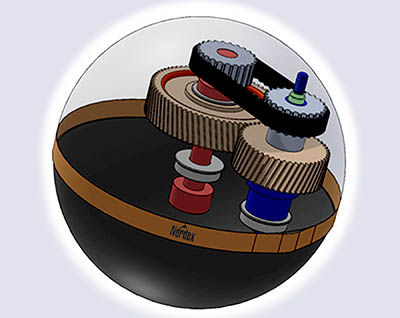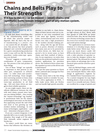Taylor Jung, product line manager,
synchronous drives, Industrial Power
Transmission N.A for the Gates Corporation,
concurs — followed by one critical
difference. “Both belts and chains
will produce some sort of contaminant
during their operation. Chains have
grease, oil, and metal particulates.
Belts will shed material over time as
well. Neither is a perfect solution. The
primary differentiation between the
two is in maintenance. Chains require
routine lubrication and more frequent
replacement. In wash-down environments,
the potential for spread of
grease and oil contamination is elevated
and the maintenance requirements
skyrocket. Polyurethane synchronous
belts do not have any of these concerns
and are a significant advantage in food
handling environments.”

Figure 1 A lumber mill roll case requiring careful synchronization and smooth operation for
stacking of boards got what it needed from Gates Corp.'s poly chain GT carbon extended
length belt (courtesy Gates Corp.).
- Click image to enlarge
Peer’s Briere counters with the fact
that “Roller chain in 304 material or
a 600 stainless can now be manufactured
with solid roller and solid bushing.
Having no seam in any of the
round parts is great for disinfecting or cleaning without crevices for bacteria
to grow. The solid bushing provides
increased bearing area to spread
and distribute the bearing load. Less
stretch with solid bushing opposed
to split bushing. Belts have a difficult
time operating in wet caustic environments
when wash-downs are required
by FDA.”
And at Tsubaki, clean-type, no-lube
applications are still in play due to
a patented steel chain. Say Hogan &
Manta: “Our Lambda chain has an extended,
longer wear life than our standard.
Our chain is lube-free thanks to
our oil-impregnated bushings, which
not only helps minimize elongation,
but also reduces downtime and maintenance
operation cost. (The) chain
is ideal for those applications where
lubrication is impractical or impossible.
Lambda has the same maximum
allowable load as our standard roller
chain. For applications with VOC limitations,
chains with no lubrication, dry
lubrication (Molykote), or plated pins
can be considered.”
Briere points out that, “If heat is
involved, then stainless is a must to
transmit power, convey or lift. If there
is an extreme, abrasive element, chains
can be hardened to survive in the tough
environment. A great example would
be cement and limestone (mills).”

Figure 2 Illustration of synchronous belt assembly (courtesy Nordex Inc).
- Click image to enlarge
Antonelli cautions that just any steel
will not work in certain applications;
homework must be done; choices
must be made. Remember — this is a
process.
“When talking about steel in general
it is important to define which type
of steel is being used,” says Antonelli.
“Standard-coated steel chain typically
does not stand up well to certain
environments such as sewage treatment
plants and salt-water locations;
stainless steel and alloy chains offer a
possibility to overcome these issues.
Also, when sludge or solids are a factor,
belts would tend to clog or entrap
the contaminating material, especially
if a wide belt would be used. The open
design of chains allow for the ‘release’
of such contaminates and make chains
more forgiving than belts in those
types of applications.”
But when talking harsh environment,
Jung reminds, “That depends on your
definition (of harsh),” he says. “On one
hand, if you have very high temperatures,
chain is likely the best option. If
caustic chemicals are present in the environment,
then polyurethane synchronous
belts will perform much better. It
is a situation-dependent answer.”
But if it’s steel — or titanium — you
require, Tsubaki, as do all the suppliers
mentioned here, offers choices. “We
typically suggest using stainless steel
chain for any extremely harsh environment
where extreme temperatures or
corrosive chemicals are encountered,”
say Hogan & Manta. “Different grades
are available, depending on the exact
environment, including our 600 series,
SS 304 stainless, NS 316 stainless steel,
TI titanium series — and even PC plastic/
steel combination chains.
“Stainless steel generally has one
drawback: load capacity. Neptune
Chain, which has a special triple coating
“galvanic” type coating over our
carbon steel chain, provides corrosion
protection and has the same performance
rating as our standard carbon
chain.”

Figure 2 Illustration of synchronous belt assembly (courtesy Nordex Inc).
- Click image to enlarge
We wondered: Are there any advantages
of one (belts) over the other
(chain) regarding use with the latest
NEMA Premium motors? Or AC- vs.
DC-drive type motor systems, for example?
Are there any other performance
differences between the two
regarding motor-type compatibilities?
“Historically,” says Nordex’s Antonelli,
“AC drives have tended to be more
rugged and cost-efficient — especially
in higher power applications — while DC drives have tended to be the choice
where high repeatability and positioning
are concerned. This is especially
true in reverse rotation and positioning
applications. There are constant
improvements in motors and control
technology, so the line dividing AC and
DC applications is tending to blur.”
Hogan & Manta explain that “Chains
are used in very precision-oriented robotics
— often used for electronics or
automation applications. Tsubaki offers
bearing-bush chains which have
a very exacting pitch tolerance; users
can often set precision accuracy close
to .005". (Our) bearing bush chain virtually
eliminates initial stretch; with
needle bearings placed between the
pin and bushing, bearing bush chain
offers excellent wear life without lubrication.
Major dimensions of the
chain and attachments are the same
as our ASME/ANSI-standard, doublepitch
conveyor chains; (it) works perfectly
with standard, over-sized roller
sprockets.”
We then had a thought — is there
ever a scenario in which both — steel
and fabricated — are used in tandem?
“A systems integrator will opt for a
belt/chain drive if it eliminates the
need for another drive motor,” says
Bob Eisele, of Amacoil Inc. The traverse
unit (see diagram) rides on a
shaft that is belted to the main motor.
If a separate drive motor was used to
power the traverse, then electronic
controls would be needed to synchronize
the linear movement of the traverse
with the rotational movement
of the spool. Using the belt or chain to
link the traverse driveshaft to the main
shaft eliminates the need for another
motor — saving time and money.”
Similarly, are there applications
where, at the end of the day, either one
is equally acceptable in both performance
and total cost? We started with
Antonelli.
“Interesting question; my take on it
would be any application where there
are few controlling factor constraints.
One trend we are noticing lately is the
elimination of belts/chains/gears altogether
by going to a direct-drive system.
This is where the motor is driving
the axis directly. This has cost, complexity
and reliability benefits.”
Jung offers that “While there are certain
situations where both technologies
have their advantages, the majority
of drives would perform better and
have a lower total cost of ownership
with synchronous belts. This is because
they do not require any regular maintenance and last longer than chain.”
Another key consideration regarding
belts/puller chains — width matters—
for various reasons. Once upon a
time, steel ruled in this regard. Things
change.
“A wider belt may exhibit more frictional
losses than a narrower belt,”
says Antonelli. “This effect is more pronounced
if the belt in question tends to
track to one side or the other. A wider
belt typically tracks with more force
than a narrower belt. A wider or multiple
chain set-up may have an issue
wear the individual chain strands or
segments stretch at different rates and
the different strands may not see the
same loads.”
Peer’s Briere states that “Belts as
friction drives are limited in ratio selection
and to transmit higher horsepower
increases the overall size due
to the need for more surface/friction.
Tooth belts simply do not have the ratio
selection and are limited in center
distance choices. Chains, on the other
hand, are extremely flexible for machine
design due to the ability to use
almost any center distance and allow
higher horsepower to be transmitted
in smaller envelope dimensions.”
Gates’ Jung: “As a general statement,
the best belt technology has been able
to match chain widths for over 10
years. With either product, appropriate
drive design is of key importance for
long term performance. Under-design
has its obvious resulting failures, but
overdesign can result in premature
failure as well, both of the belt and
connected equipment.” And Tsubaki’s
Hogan & Manta explain: “On a chain,
increasing the width (multi-strand)
will increase the chain’s working load
and the average tensile strength, while
keeping sprocket diameters small. In
general, for a given width, chain can
often be narrower than belts for a given
RPM and power requirement.”
There’s more to this part of the design
process than we currently have
space for — we haven’t even touched
upon things like software, bearings
integration; ease-of-replacement; lifetimes…
Be we’ve left space for a bit of crystal
ball gazing — e.g., belts, chains, glasses
half-empty, half-full, etc.
“Chains have a future in the applications
that I have mentioned in the
questions above,” says Jung. “Synchronous
belt technology has more potential
for innovation and its capabilities
will grow faster than chain, leading to
a perpetual, if ever narrowing market.
The capability of carbon fiber tensile
cords has not yet been fully explored.
All of the surrounding belt components
continue to be improved in order
to fully utilize the strength of the
carbon fiber cord. I don’t feel that it
is possible to identify the limits of the
technology at this time.”
But men of steel — fear not
Says Peer Chain’s Briere on whether
there is a future for roller chain-type
drive applications:
“There will always be a need for a
positive drive.”
For more information:
The Gates Corporation
1551 Wewatta Streeet
Denver, CO 80202
Phone: (303) 744-5216
www.Gates.com
Nordex Inc.
426 Federal Road
Brookfield, CT 06804
Phone: (800) 243-0986
Fax: (203) 775-6552
info@nordex.com
Peer Chain Company
Chuck Briere, National Sales Manager
2300 Norman Drive
Waukegan, IL 60085
cbriere@PEERchain.com
U.S. Tsubaki Power Transmission LLC
301 E. Marquardt Drive
Wheeling, IL 60090
Phone: (847) 459-9500; (800) 323-7790
Fax: (847) 459-9515
sales@ustsubaki.com
About Author
Jack McGuinn
Jack McGuinn, Senior Editor, has a diverse, 20-year history in manufacturing, including management-level positions in quality assurance and testing; product development; marketing and promotion; and industrial journalism. He has been with Gear Technology since 2005. [10 years in the gear industry]









